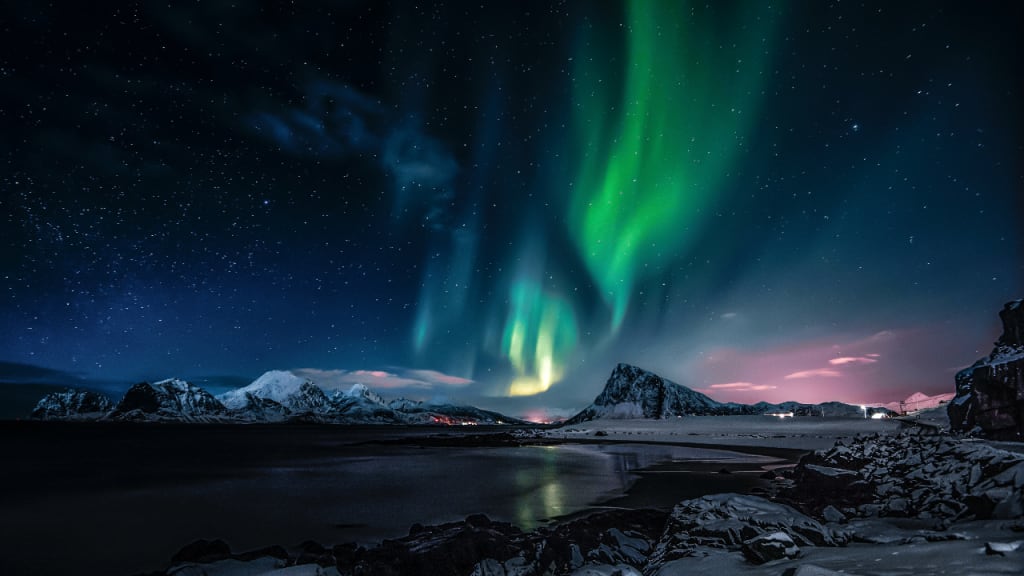What causes Aurora Borealis?
All about the Northern Lights

Step into the enchanting realm of one of Earth's most mystical spectacles: the Northern Lights, or as they're poetically termed, the aurora borealis. Embark with me on an odyssey to unveil the enigmas veiled within these spellbinding cosmic exhibitions and delve into the scientific marvels underpinning their breathtaking allure.
My adventure with the Northern Lights began in the far reaches of Northern Canada, where I had the privilege of witnessing this extraordinary spectacle firsthand. Standing in my sister Heather's backyard, I gazed up at the night sky, mesmerized by the ethereal greenish glow that danced across the horizon. It was a moment of pure magic, one that left an indelible impression on my soul.
But what exactly causes the Northern Lights? This question has intrigued scientists and sky watchers alike for centuries. To understand the answer, we must first delve into the science of our planet's magnetosphere and the interaction between solar particles and Earth's atmosphere.
When charged particles emitted by the sun, known as solar wind, collide with the Earth's magnetic field, they are directed towards the polar regions. As these charged particles interact with gases in the upper atmosphere, such as oxygen and nitrogen, they emit photons of light, creating the stunning auroral displays we know as the Northern Lights.
While the most common color associated with the aurora is green, caused by the interaction of solar particles with oxygen atoms, they can also appear in hues of red, purple, and pink, depending on the altitude and atmospheric conditions.
One of the most fascinating aspects of the Northern Lights is their dynamic nature. Unlike static images captured in photographs, the aurora is a living, breathing phenomenon that evolves and shifts in real-time. Watching the curtains of light dance across the night sky is a truly awe-inspiring experience that defies description.
But why are the Northern Lights primarily visible near the poles? The answer lies in the Earth's magnetic field, which is strongest at the North and South Poles. This magnetic field acts as a funnel, channeling solar particles towards the polar regions and increasing the likelihood of auroral activity.
While the Northern Lights are most commonly associated with regions like Canada, Alaska, and Scandinavia, they can also be observed in southern latitudes under the right conditions. In fact, sightings of the aurora have been reported as far south as New Zealand and Antarctica, offering a glimpse of their celestial splendor to fortunate observers around the globe.
The cultural significance of the Northern Lights cannot be overstated. For indigenous peoples living in the Arctic regions, the aurora borealis has long been woven into the fabric of their mythology and folklore. Stories of spirits dancing in the night sky and messages from the gods abound, reflecting the deep spiritual connection between these communities and the natural world.
In addition to their cultural significance, the Northern Lights also hold scientific value, offering researchers valuable insights into the dynamics of our planet's magnetosphere and the behavior of solar particles in near-Earth space. By studying the aurora, scientists can gain a better understanding of space weather phenomena and their potential impact on Earth's technological infrastructure.
As our understanding of the Northern Lights continues to evolve, so too does our appreciation for the wonders of the natural world. Whether viewed through the lens of science or experienced as a moment of pure wonder and awe, the aurora borealis remains a testament to the beauty and complexity of our universe.
So the next time you find yourself gazing up at the night sky, remember to look for the telltale signs of the Northern Lights. Who knows? You may be lucky enough to witness one of nature's most breathtaking displays and experience a moment of pure magic under the dancing lights of the aurora.
About the Creator
Dilesmeyyy<3
i just like to read
Enjoyed the story? Support the Creator.
Subscribe for free to receive all their stories in your feed. You could also pledge your support or give them a one-off tip, letting them know you appreciate their work.






Comments
There are no comments for this story
Be the first to respond and start the conversation.